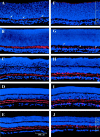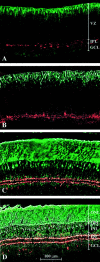Depletion of cholinergic amacrine cells by a novel immunotoxin does not perturb the formation of segregated on and off cone bipolar cell projections
- PMID: 11896166
- PMCID: PMC6758270
- DOI: 10.1523/JNEUROSCI.22-06-02265.2002
Depletion of cholinergic amacrine cells by a novel immunotoxin does not perturb the formation of segregated on and off cone bipolar cell projections
Abstract
Cone bipolar cells are the first retinal neurons that respond in a differential manner to light onset and offset. In the mature retina, the terminal arbors of On and Off cone bipolar cells terminate in different sublaminas of the inner plexiform layer (IPL) where they form synapses with the dendrites of On and Off retinal ganglion cells and with the stratified processes of cholinergic amacrine cells. Here we first show that cholinergic processes within the On and Off sublaminas of the IPL are present early in development, being evident in the rat on the day of birth, approximately 10 d before the formation of segregated cone bipolar cell axons. This temporal sequence, as well as our previous finding that the segregation of On and Off cone bipolar cell inputs occurs in the absence of retinal ganglion cells, suggested that cholinergic amacrine cells could provide a scaffold for the subsequent in-growth of bipolar cell axons. To test this hypothesis directly, a new cholinergic cell immunotoxin was constructed by conjugating saporin, the ribosome-inactivating protein toxin, to an antibody against the vesicular acetylcholine transporter. A single intraocular injection of the immunotoxin caused a rapid, complete, and selective loss of cholinergic amacrine cells from the developing rat retina. On and Off cone bipolar cells were visualized using an antibody against recoverin, the calcium-binding protein that labels the soma and processes of these interneurons. After complete depletion of cholinergic amacrine cells, cone bipolar cell axon terminals still formed their two characteristic strata within the IPL. These findings demonstrate that the presence of cholinergic amacrine cells is not required for the segregation of recoverin-positive On and Off cone bipolar cell projections.
Figures







Similar articles
-
Assembly and disassembly of a retinal cholinergic network.Vis Neurosci. 2012 Jan;29(1):61-71. doi: 10.1017/S0952523811000216. Epub 2011 Jul 26. Vis Neurosci. 2012. PMID: 21787461 Free PMC article. Review.
-
Segregation of on and off bipolar cell axonal arbors in the absence of retinal ganglion cells.J Neurosci. 2000 Jan 1;20(1):306-14. doi: 10.1523/JNEUROSCI.20-01-00306.2000. J Neurosci. 2000. PMID: 10627608 Free PMC article.
-
Ectopic photoreceptors and cone bipolar cells in the developing and mature retina.J Neurosci. 2003 Feb 15;23(4):1383-9. doi: 10.1523/JNEUROSCI.23-04-01383.2003. J Neurosci. 2003. PMID: 12598626 Free PMC article.
-
Morphological differentiation of bipolar cells in the ferret retina.Vis Neurosci. 1999 Nov-Dec;16(6):1133-44. doi: 10.1017/s0952523899166136. Vis Neurosci. 1999. PMID: 10614593
-
Development of On and Off retinal pathways and retinogeniculate projections.Prog Retin Eye Res. 2004 Jan;23(1):31-51. doi: 10.1016/j.preteyeres.2003.10.001. Prog Retin Eye Res. 2004. PMID: 14766316 Review.
Cited by
-
Recruitment of the rod pathway by cones in the absence of rods.J Neurosci. 2004 Aug 25;24(34):7576-82. doi: 10.1523/JNEUROSCI.2245-04.2004. J Neurosci. 2004. PMID: 15329405 Free PMC article.
-
Cholinergic neural activity directs retinal layer-specific angiogenesis and blood retinal barrier formation.Nat Commun. 2019 Jun 6;10(1):2477. doi: 10.1038/s41467-019-10219-8. Nat Commun. 2019. PMID: 31171770 Free PMC article.
-
Targeted destruction of photosensitive retinal ganglion cells with a saporin conjugate alters the effects of light on mouse circadian rhythms.PLoS One. 2008 Sep 5;3(9):e3153. doi: 10.1371/journal.pone.0003153. PLoS One. 2008. PMID: 18773079 Free PMC article.
-
Assembly and disassembly of a retinal cholinergic network.Vis Neurosci. 2012 Jan;29(1):61-71. doi: 10.1017/S0952523811000216. Epub 2011 Jul 26. Vis Neurosci. 2012. PMID: 21787461 Free PMC article. Review.
-
Developmental mechanisms that regulate retinal ganglion cell dendritic morphology.Dev Neurobiol. 2011 Dec;71(12):1297-309. doi: 10.1002/dneu.20900. Dev Neurobiol. 2011. PMID: 21542137 Free PMC article.
References
-
- Batchelor PE, Armstrong DM, Blaker SN, Gage FH. Nerve growth factor receptor and choline acetyltransferase colocalization in neurons within the rat forebrain: response to fimbria-fornix transection. J Comp Neurol. 1989;284:187–204. - PubMed
-
- Bodnarenko SR, Chalupa LM. Stratification of ON and OFF ganglion cell dendrites depends on glutamate-mediated afferent activity in the developing retina. Nature. 1993;364:144–146. - PubMed
-
- Brown SP, Masland RH. Costratification of a population of bipolar cells with the direction-selective circuitry of the rabbit retina. J Comp Neurol. 1999;408:97–106. - PubMed
Publication types
MeSH terms
Substances
Grants and funding
LinkOut - more resources
Full Text Sources
